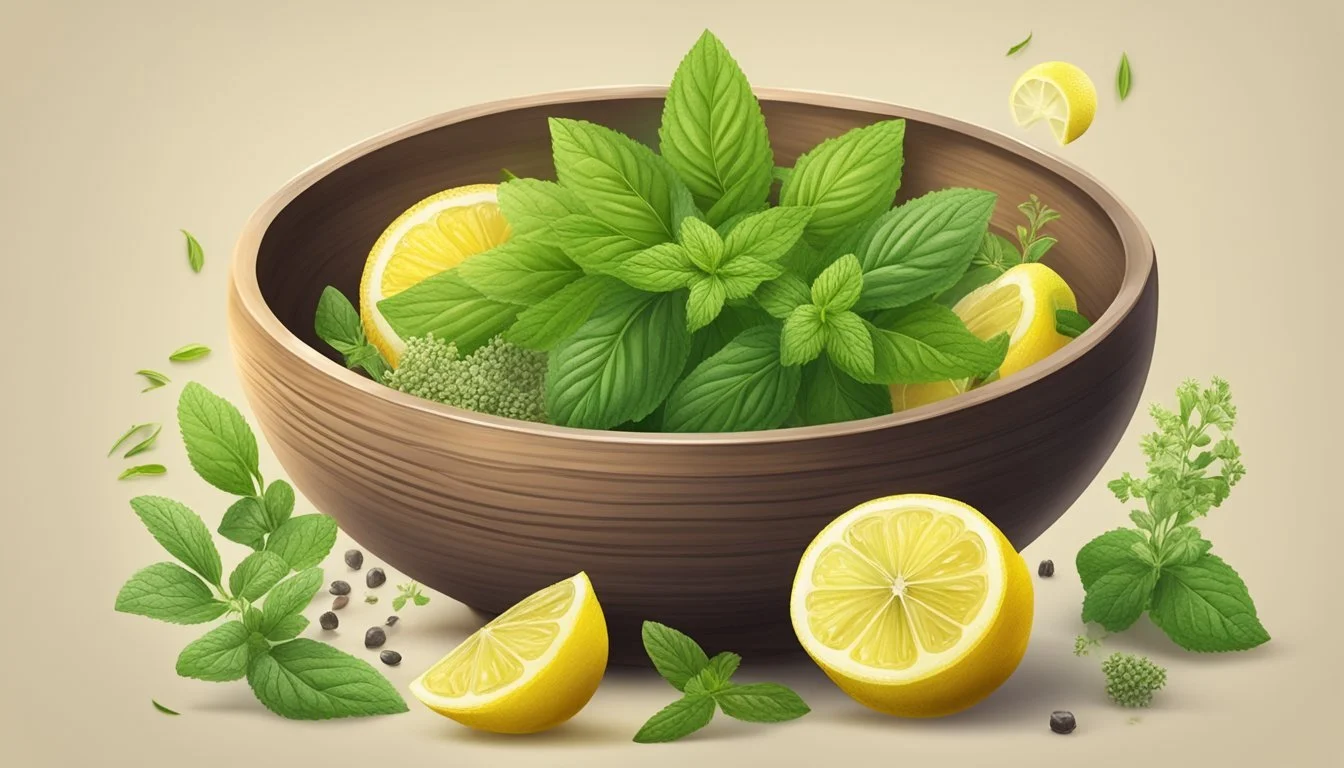Lemon Balm Substitutes
Best Alternatives for Flavor and Health
Finding a suitable substitute for lemon balm (Melissa officinalis) can be crucial for both culinary and therapeutic purposes. Lemon balm, known for its fresh herb aroma and lemony scent, can be effectively replaced by combining mint leaves with lemon zest. This combination provides the much-needed background flavor and citrus tang that lemon balm brings to dishes.
For those seeking an herb with a stronger flavor profile, lemon verbena is an excellent option. It not only mirrors the lemony aroma of lemon balm but can also be used in smaller quantities, making it a potent substitute. Additionally, lemongrass offers a vibrant lemony flavor, making it ideal for teas, soups, and marinades, while also boasting calming effects similar to those of lemon balm.
These substitutes ensure that your recipes maintain their intended flavor profile without compromising on the distinct lemony essence that makes lemon balm a beloved ingredient.
Understanding Lemon Balm
Lemon balm, also known as Melissa officinalis, is a versatile leafy herb that offers a delightful lemony scent and flavor. This perennial herb is prized for both its culinary uses and its ease of cultivation.
Characteristics of Lemon Balm
Lemon balm belongs to the mint family and features heart-shaped, bright green leaves. These leaves are often slightly fuzzy and emit a strong lemon fragrance when bruised. The aroma is due to the essential oils present in the leaves, which include compounds like citronellal and geraniol.
The plant typically grows to about 2 feet tall and can spread up to 2 feet wide. It's a hardy plant that thrives in USDA zones 4 through 9. Lemon balm is perennial, meaning it grows back each year without needing to be replanted.
Culinary Uses of Lemon Balm
Lemon balm is a popular ingredient in both sweet and savory dishes. Its lemony flavor pairs well with fish, poultry, and vegetable dishes. The herb can be used either fresh or dried. Fresh lemon balm is often used in salads, sauces, and marinades.
In beverages, lemon balm is an excellent addition to teas, cocktails, and fruit punches. It's also used in herbal infusions and syrups, adding a refreshing note to drinks. Melissa officinalis is sometimes included in desserts such as sorbets, ice creams, and baked goods for a light citrus touch.
Growing Lemon Balm at Home
Growing lemon balm is relatively straightforward, making it a favorite among gardeners. The plant prefers well-drained soil and partial to full sunlight. It can be grown from seeds, cuttings, or purchased plants from nurseries.
Lemon balm requires regular watering to keep the soil moist but not waterlogged. This helps in maintaining the herb's vibrant leaf color and strong aroma. It can be grown in garden beds or containers, providing flexibility for those with limited space.
The growing season typically stretches from spring to late summer. Pruning the plant encourages bushier growth and prevents it from becoming too leggy. Fresh leaves can be harvested as needed, while dried lemon balm should be stored in an airtight container away from light to preserve its quality.
Top Lemon Balm Substitutes
Lemon balm substitutes provide similar flavors and aromas for recipes where lemon balm is unavailable. Each substitute has unique characteristics that make it suitable for different culinary uses.
Lemon Thyme
Lemon thyme is one of the most versatile substitutes for lemon balm. It has a strong lemony scent and taste, combining citrus flavor with the earthy notes of thyme. This herb works well in both savory and sweet dishes, making it a great addition to sauces, marinades, and even desserts. It's best used fresh, as the leaves release a more potent aroma when they're fresh.
Lemon Verbena
Lemon verbena offers a potent citrus flavor, even stronger than lemon balm. Its leaves are bright and fragrant, making it ideal for teas, syrups, and desserts. This herb can be used in similar quantities to lemon balm due to its strong flavor. Lemon verbena is particularly good for infusions, where its intense citrus notes can really shine.
Lemongrass
Lemongrass brings a unique lemony flavor with a hint of ginger. This herb is commonly used in Asian cuisines but can replace lemon balm in a variety of recipes. It's great in soups, stews, and curries. To use lemongrass, remove the tough outer layers and finely chop the inner stalks. Lemongrass has a powerful aroma that can elevate the dish's overall flavor profile.
Lemon Zest
Lemon zest is the finely grated outer skin of the lemon and is a strong, concentrated source of citrus flavor. It can be used as a direct substitute for lemon balm in most recipes, especially where a fresh, zesty note is needed. A small amount of zest goes a long way, making it ideal for dressings, marinades, and desserts. Fresh lemon zest is preferred as it retains essential oils that contribute to its robust flavor.
Mint Leaves
Mint leaves combined with lemon zest can mimic the flavor profile of lemon balm. Mint provides a refreshing, cool taste while the lemon zest adds the necessary citrus kick. This combination is particularly effective in beverages, salads, and garnishes. Use freshly chopped mint and freshly grated lemon zest for the best results, considering a ratio of roughly one part mint to half a part lemon zest to balance the flavors.
These substitutes can effectively replace lemon balm in various recipes, providing similar flavors and aromas to enhance your culinary creations.
Lemon Balm Substitutes in Cooking
Lemon balm offers a distinct lemony flavor that enhances both sweet and savory dishes as well as beverages. When it isn't available, several substitutes can replicate its citrusy essence in various culinary contexts.
For Sweet Dishes
For baking and other sweet dishes, lemon zest is an excellent substitute. It provides a strong lemon flavor that can invigorate cakes, cookies, and pastries. Using 1 to 2 teaspoons of freshly grated lemon zest per tablespoon of lemon balm will usually suffice.
Another good option is lemon extract. It is more concentrated than zest, so only a few drops will be necessary to replicate the flavor. For an added herbal touch, combining lemon zest with fresh mint leaves can also work well.
A mix of lemon juice and a small amount of honey can be used in frostings and custards for a similar effect. The acidity of the lemon juice balances the sweetness without overpowering the dish.
For Savory Recipes
In savory dishes such as soups, salads, and sauces, lemon zest combined with fresh mint or basil can replicate both the citrus and herbal notes of lemon balm. For vinaigrettes and lighter sauces, lemon juice mixed with chopped fresh herbs will work efficiently.
In more intense dishes like soups or tart sauces, kaffir lime leaves can serve as an alternative. They offer a more potent citrus flavor, so their use should be more conservative.
Lemon verbena is another viable substitute, especially when a more pronounced herbal note is desired. It can work well in salads and lighter savory dishes, offering both the necessary citrus flavor and a herbal complexity.
For Beverages
When making herbal teas or flavoring beverages, lemon zest and fresh mint are ideal substitutes. For each tablespoon of lemon balm in tea recipes, use 1 teaspoon of lemon zest and a few mint leaves.
Chamomile can be a calming addition to teas that typically use lemon balm. It provides a gentle flavor that complements other herbs well. For a more direct lemon flavor, lemon basil can be an alternative, adding both the citrus and herbal aspects.
In cocktails, mix lemon juice with a touch of vinegar to replicate the tartness of lemon balm. This works particularly well in gin or vodka-based drinks that benefit from the additional acidity.
These substitutes ensure that the missing lemon balm doesn't hinder the final flavor of your dish or beverage, maintaining both integrity and taste.
Alternative Ingredients with Lemon Aroma
There are various ingredients that can effectively substitute for lemon balm's characteristic lemon aroma and flavor. These alternatives range from fresh citrus peels and juices to citrusy herbs and spices, each with its unique applications and benefits.
Using Citrus Peels
Citrus peels, particularly lemon, lime, and orange zest, are excellent alternatives due to their strong lemon scent and citrus flavor. Lemon zest is the most recommended because it provides a potent lemony aroma and adds a subtle sweetness to dishes.
To use, simply grate the outer skin of the fruit, avoiding the bitter white pith beneath. Lime zest offers a sharper and more intense flavor, while orange zest brings a sweeter and more complex citrus profile. These peels can be used in both savory and sweet recipes, such as salads, marinades, and desserts, to capture the fresh, vibrant essence of lemon balm.
Citrus Juices and Zests
Fresh juices and zests from citrus fruits like lemons, limes, and oranges are natural and readily available substitutes. Lemon juice provides an acidic kick and bright flavor, making it ideal for recipes requiring both tartness and lemon aroma. Similarly, lime juice and lime zest offer a pronounced citrusy flavor with a slightly bitter edge.
Orange zest, although subtler, adds a sweet citrus note and can offer a milder alternative. These juices and zests are versatile and can enhance the flavor profile of dressings, sauces, baked goods, and beverages. They can be used in both raw and cooked dishes, adding a fresh and tangy taste indicative of lemon balm.
Citrusy Herbs and Spices
Herbs and spices with a citrus aroma, such as lemongrass and coriander, can also serve as substitutes for lemon balm. Lemongrass is notable for its robust, citrusy flavor and aroma. It is often used in Asian cuisines and imparts a lemony scent and flavor that is both refreshing and potent.
Coriander leaves, also known as cilantro, possess a subtle citrus note alongside their fresh, herbal flavor. These herbs are excellent in soups, stews, and marinades. They provide both the lemony essence and the versatility needed to replace lemon balm in various dishes.
Health and Wellness
Lemon balm, also known as Melissa officinalis, offers numerous health benefits through its calming properties, aiding digestion, and reducing inflammation. This herb is rich in antioxidants and essential oils, and its versatile use extends to both culinary and medicinal applications.
Lemon Balm for Stress Relief
Lemon balm is renowned for its stress-relief properties. The herb contains compounds that have a calming effect on the nervous system.
Many individuals use lemon balm in the form of herbal tea or essential oils. The aroma of lemon balm can help reduce anxiety and promote relaxation. Studies suggest that compounds like rosmarinic acid enhance the herb's ability to modulate mood and calm the body.
Digestive Benefits of Lemon Balm
This herb is beneficial for digestive health. Lemon balm can help alleviate digestive disorders such as bloating, cramps, and indigestion.
Its essential oils, including citral and citronellal, provide a gentle cooling sensation and can soothe the gastrointestinal tract. Consuming lemon balm tea after meals can promote a more comfortable digestion process, making it a popular herbal remedy for stomach discomfort.
Lemon Balm as an Anti-inflammatory
Lemon balm exhibits notable anti-inflammatory properties. This makes it useful for conditions involving inflammation.
The antioxidants found in lemon balm, such as caffeic acid and quercetin, help reduce oxidative stress and inflammation. Applying lemon balm topically can provide relief from skin irritations and inflammation. Its essential oils facilitate healing and reduce redness, enhancing overall skin health.
Sourcing and Storing Substitutes
Obtaining and preserving optimal substitutes for lemon balm involves selecting items from reliable sources and properly maintaining their freshness. Key considerations include buying quality herbs and ensuring they are stored correctly to retain their flavor and potency.
Where to Purchase Substitutes
Fresh and dried substitutes for lemon balm can be found in various places. Grocery stores are ideal for sourcing fresh herbs like mint leaves, which pair well with fresh lemon zest. Look for high-quality produce sections where fresh herbs are regularly stocked.
For items like dried lemongrass or dried lemon peel, specialty food stores or international markets offer a broader selection. Nurseries or garden centers can be a good choice for picking up potted herbs that you can grow at home, providing a continuous supply.
Online retailers also stock a wide range of substitutes, from dried lemon balm to other dried herbs. Always check for reputable suppliers to ensure the herbs are fresh and free from contaminants.
Storing Herbs and Zests Properly
Proper storage is crucial for maintaining the potency of herbs and zests. Fresh herbs like mint should be stored in the refrigerator, ideally in a glass of water covered with a plastic bag. This method can extend their freshness for up to a week.
Dried herbs such as dried lemon peel should be kept in airtight containers in a cool, dark place. This will help preserve their essential oils and flavor for several months.
For fresh lemon zest, consider freezing it in small portions to use as needed. Place the zest in a freezer-safe bag, removing as much air as possible to prevent freezer burn and ensure maximum flavor retention.
Preparing Substitutes
When replacing lemon balm in recipes, understanding proper measurements, how to enhance flavor, and creative applications is crucial. Different substitutes like lemongrass require specific preparation techniques to ensure desired results.
Measurements and Equivalents
Precise measurements ensure the substitute delivers similar flavor intensity. For instance, three lemon balm leaves can replace one stalk of lemongrass. This ratio is important as lemon balm has a milder citrus flavor.
For other substitutes:
Lemon zest: Use 1 teaspoon of lemon zest per tablespoon of chopped lemon balm.
Kaffir lime leaves: Substitute one leaf for three lemon balm leaves since they are more potent.
Lemon juice: Generally, 1 teaspoon of lemon juice equals 1 tablespoon of fresh lemon balm.
Enhancing Flavor Through Preparation
To maximize the aroma and taste from substitutes, preparation is key. Kaffir lime leaves benefit from bruising before use to release oils. Gently crush the leaves before adding them to recipes.
Lemon zest brings out more flavor when finely grated. Use a microplane for best results. For lemongrass, slicing it thinly or crushing its stalks helps to infuse its essence.
Simmering substitutes lightly can open up their full profile. For tea, steeping lemon balm replacements like lemongrass or lime zest for around 5 minutes will extract more aroma and flavor.
Creative Uses in Recipes
Replace lemon balm with alternatives in a variety of dishes:
Teas: Infuse hot water with lemon zest or kaffir lime leaves for a citrusy beverage.
Desserts: Use lemon zest in place of lemon balm in cookies and cakes for a fresh twist.
Savory Dishes: Try lime zest or lemon juice in marinades or salads to mimic the mild citrus notes of lemon balm.
Garnishing with lemon zest or crushed lime leaves adds a fresh appearance and bursts of flavor to dishes. Incorporating these substitutes creatively maintains the integrity of your recipe while enhancing it with a new depth of flavor.








